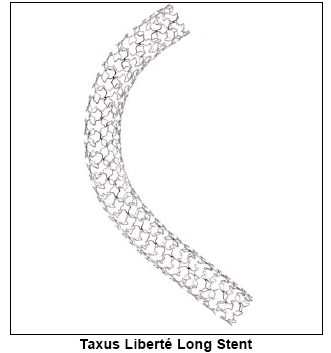Back in May, Boston Scientific (Natick, Massachusetts) took a huge leap ahead of its competition by gaining a nod of approval from the FDA to commercialize its Taxus Liberté Atom stent – for use in vessels as small as 2.25 mm in diameter (Medical Device Daily, May 28, 2009). Promising to be the smallest on the market, the drug-eluting stent (DES) is said to offer greater flexibility and navigation through vessels.
Now two months later the company is, to borrow a phrase from football, "going long" by offering what it says is the largest stent size on the market, through its Taxus Liberté Long paclitaxel-eluting coronary stent system. At 38 mm, the DES is said to provide doctors with an option that can potentially reduce the number of stents used in more complex cases, simplifying procedures and reducing costs. It affords a more efficient treatment option for the estimated 8% to 10% of patients with long lesions.
On Thursday, the company reported getting FDA approval to market the stent system with a launch date sometime in August. The system has already been launched in Europe and received CE mark approval back in 2007.
"There are some definite benefits with Liberté Long – for one thing physicians can treat lesions by using one stent, Mark Fligge, group marketing manager for Boston Scientific's Drug Eluting Stent division, told Medical Device Daily. In the past physicians have either had to use one stent or more, or they weren't treating the entire disease at one time. So you're able to treat the lesion with one device and that in turn eliminates placement errors which could eventually lead to restenosis."
He said that the stent system has been thoroughly evaluated. Taxus stents have been in several randomized, controlled clinical trial program, with follow-up to five years in some cases. These trial results have been supplemented by data on more than 35,000 patients enrolled in post-approval registries.
"The Taxus Liberté Long Stent offers physicians and patients distinct advantages compared to using two overlapping drug-eluting stents," said Mark Turco, MD, FACC, FSCAI, and Director of the Center for Cardiac & Vascular Research at Washington Adventist Hospital (Takoma Park, Maryland). "In the ATLAS Long Lesion Trial, the 38 mm Taxus Liberté stent significantly reduced myocardial infarction when compared to the Taxus Express Stent, making the Taxus Liberté Long Stent an attractive option for interventional cardiologists faced with long, challenging lesions."

The Taxus ATLAS Long Lesion Trial findings boasted a significant 79% reduction in the rate of nine-month myocardial infarction for the Taxus Liberté Long stent as compared to the Taxus Express Stent control (1.3% vs. 6.3%). At two years, the composite measure of cardiac death or myocardial infarction showed a significant 63% reduction for the Taxus Liberté Long stent compared to the Taxus Express stent (3.5% vs. 9.4%). The rate of stent thrombosis at two years was 0% for the Taxus Liberté Long stent and 0.8% for the Taxus Express stent.
In the Taxus ATLAS Long Lesion Trial, the Taxus Liberté Long stent met its primary endpoint of non-inferiority to the Taxus Express control stent in nine-month percent diameter stenosis (31.7% vs. 32.6%) and reported a 36% reduction in MACE (9.4% vs. 14.8%).
The positive results of the trial was one of the main factors in the quick release of both the Atom and Liberté Long – which stand to gain a combined total of 13% market share.
"We really don't see competition for these products in the next two years," Fligge said.
But Taxus' biggest challenge comes from Abbott (Abbott Park, Illinois) and its Xience Prime DES. Nearly a month ago, the company reported getting clearance for an indication of the stent which is just a few millimeters smaller than the Taxus Liberté Long.
All of the stents are expected to dominate a market previously filled by first-generation DES devices, such as the Cypher from Johnson & Johnson's (J&J; New Brunswick, New Jersey) Cordis (Miami Lakes, Florida) unit.
Friggle said plans call for the company to launch its 3rd generation of DES sometime in 2011 in Europe. He said that the Taxus Liberté Atom and Long stent systems have a shelf life of another three years or so.
